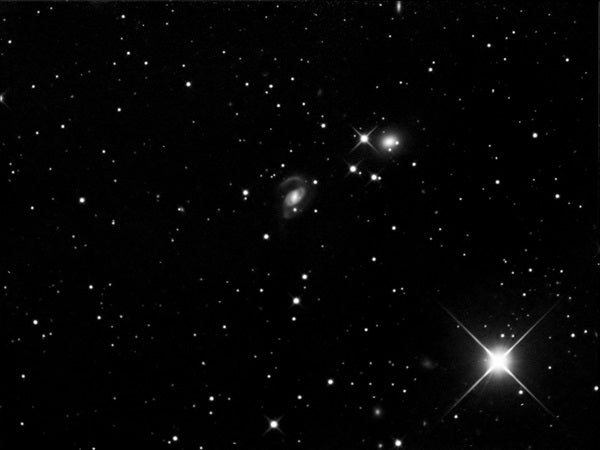An observer’s current technology can limit the ability to answer scientific questions. Film replaced visual observing and CCD chips have now replaced film. And the Hubble Space Telescope and other modern observatories have allowed discoveries far surpassing those achievable with the once all-important Palomar 200-inch telescope.
Halton C. Arp’s research into peculiar galaxies highlights this march of science. In the mid-20th century, he observed with Palomar’s scope that in many cases, two galaxies appeared close to one another on the sky but had discordant redshifts. Arp hypothesized that these conflicting redshifts arose because, although the galaxies truly were close, one of the two was made from material being ejected by the other.
NGC 4319 and Markarian 205 were one of Arp’s most prominent examples. Though Arp reported the two galaxies were connected by a “luminous bridge,” redshifts put NGC 4319 at 80 million light-years away and Markarian 205 at 1 billion — 14 times more distant! Today, Hubble shows Arp’s purported bridge is actually part of a larger envelope surrounding the foreground galaxy.
NGC 4319 is the brighter member of Arp’s duo at magnitude 12.8. It is 3′ by 2′ across and classified as an SBab barred spiral with a large central hub. The arms at the end of the bar include counter-arms, giving it a ring-shaped appearance. Markarian 205 is considered one of the closest quasars. At magnitude 14.5, it is visible with a 10- to 12-inch scope under skies free of light pollution. This object appears starlike, as the galaxy in which the bright quasar is embedded only became visible with Hubble. When you look at Markarian 205, the photons your eyes are receiving were emitted at a time when simple multicellular plant life began appearing in terrestrial sedimentary rocks during the late Precambrian.
Faint galaxies are always a challenge to find using the star-hop method. This duo is located one-third of the way between Kappa (κ) Draconis and Polaris, forming the apex of a large right triangle with Kappa and Lambda (λ) Draconis. There’s also a 5th-magnitude star located about 0.2° southeast of this galactic pair.
Make sure to explore Astronomy’s full list of 101 cosmic objects you must see. New entries will be added each week throughout 2022.
To get the latest astronomical news and observing content delivered directly to your door, subscribe to Astronomy magazine today!










